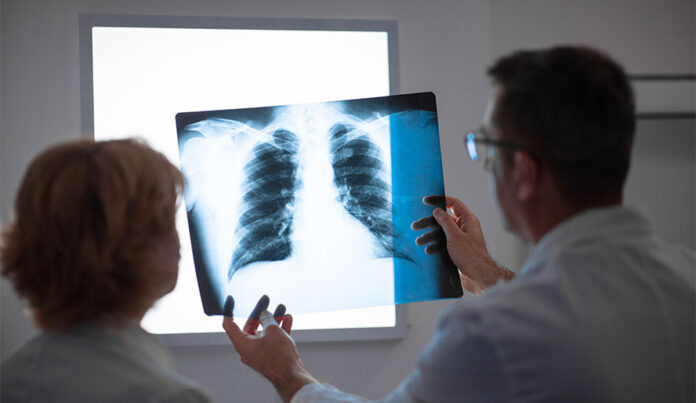The couple immediately went to the nearest hospital and, following some tests such as lung scans, were given the devastating report that Pearsall was diagnosed with the stage of 3A non-small-cell lung cancer (NSCLC) -the most frequent kind of lung cancer in the United States, accounting for around 85 percent of cases.
NSCLC is the uncontrolled development of cancerous cells in the lung tissue which can cause tumors and expand to other parts of the body, eventually becoming life-threatening. The estimated number of men who could become diagnosed as having lung cancer this year in accordance with the American Cancer Society.
“The doctor stood by my bed, and told me, in front of my kids, that I had cancer and that I was going to die,” Pearsall is a machine operator located in New Haven, Connecticut, recalls. “When I asked him what he meant by that, he said, ‘Everybody has to die.’ I started yelling — I was so upset.”
Then, Pearsall was informed that he’d need surgery to remove the tumor.
“My wife is a nurse’s aide and she got very upset at that point,” Pearsall states. “She thought we should get a second opinion.”
Then, a few days later they spoke to Anne Chiang, MD PhD who is an Yale doctor who is a part of the Thoracic Oncology group located at the Yale Smilow Cancer Hospital in New Haven. In the Yale’s Interventional Oncology program, Dr. Chiang suggested Pearsall consider an alternative to surgery. This could be the following six weeks of getting a combination of chemotherapy and radiation.
Pearsall accepted and began his treatment. He suffered from severe fatigue and hair loss but had no long-lasting adverse effects, other than scar tissue and a little anxiety. He completed his treatment in January of 2015 and is in remission ever since.
“If you met me today, you would never believe I had cancer,” the doctor states. “I go for scans every year, and seeing Chiang gives me comfort even though she told me I don’t need to see her anymore.”
What’s changed is that since Pearsall’s diagnosis Pearsall became an advocate, encouraging people to raise the issue of the cancer and to campaign for better health care.
Here’s what Chiang and Chiang would like readers to be aware of playing an active part within getting your cancer treatment and how you can participate in the treatment plan you have created.
Pearsall’s Advice
No. 1: Push for the Right Treatment Course
Pearsall claims that it was wife that made him think twice about having surgery and to talk with a different doctor regarding your cancer treatments. “I would have gone ahead and had the surgery,” Pearsall declares. “Luckily, she was there to push me to get a second opinion.”
#2: Be Open About Your Diagnosis
Within his circle, Pearsall avoided talking about his cancer. However, that’s gradually changing. Also, he found it beneficial to attend support group meetings to talk about his experiences with fellow cancer patients. “I say you have to be open about it,” the doctor declares. “I look at all the ads of St. Jude’s and I can see how resilient those children are. I’ll never forget watching children coming out of chemotherapy while I was having my own. This gave me confidence. It is important to let people know that you are not alone and that you are able to overcome it.”
No. 3: Be There for Others
Pearsall is always willing to offer suggestions and advice for managing the effects of cancer treatment. “If someone asks me what cancer treatment is like I tell them how much it helped that my wife made me homemade chicken soup and I remind them that they have to make sure to drink Ensure to get the vitamins and minerals they need,” Pearsall states. He also reminds people that if they have a loved one who has cancer and they love them, they shouldn’t behave or treat the person differently. “Love them just the way they are.”
Dr. Chiang’s Advice
No. 1: Surgery Isn’t Always Better
While some patients may believe that surgery is the most effective alternative if a tumor has been discovered, this isn’t always the scenario. A treatment plan that includes radiation, chemotherapy or both could be more efficient. “There’s a lot of education that we try to do around this,” she states. “Taking it [the tumor] out isn’t always the answer.”
No. 2: Make Sure You Understand Your Options
Your doctor will clearly explain the treatment suggested to you, says Chiang. They must also inform you about the possibility of a clinical trial, in case it’s available. “I feel strongly that you don’t have to understand cell physiology or drug pharmacology, but it’s important that patients understand what their options are and why your doctor favors one over the other,” she declares. “If you understand your treatment course you will be better able to participate in your care and ask the right questions.”
No. 3: Find an Advocate
Like Pearsall the majority of people turn on a family member to act as an advocate. You can, however, select a person to accompany you to appointments. “This person should be a second pair of ears who asks questions for you,” she adds. This person could also relay details for the cancer patient as well and, if required it is recommended that there be an interpreter for the language within the room. “We’re very aware of how important it is to engage and talk to family members — not just treat the patient but to offer the broadest support possible,” she says.
